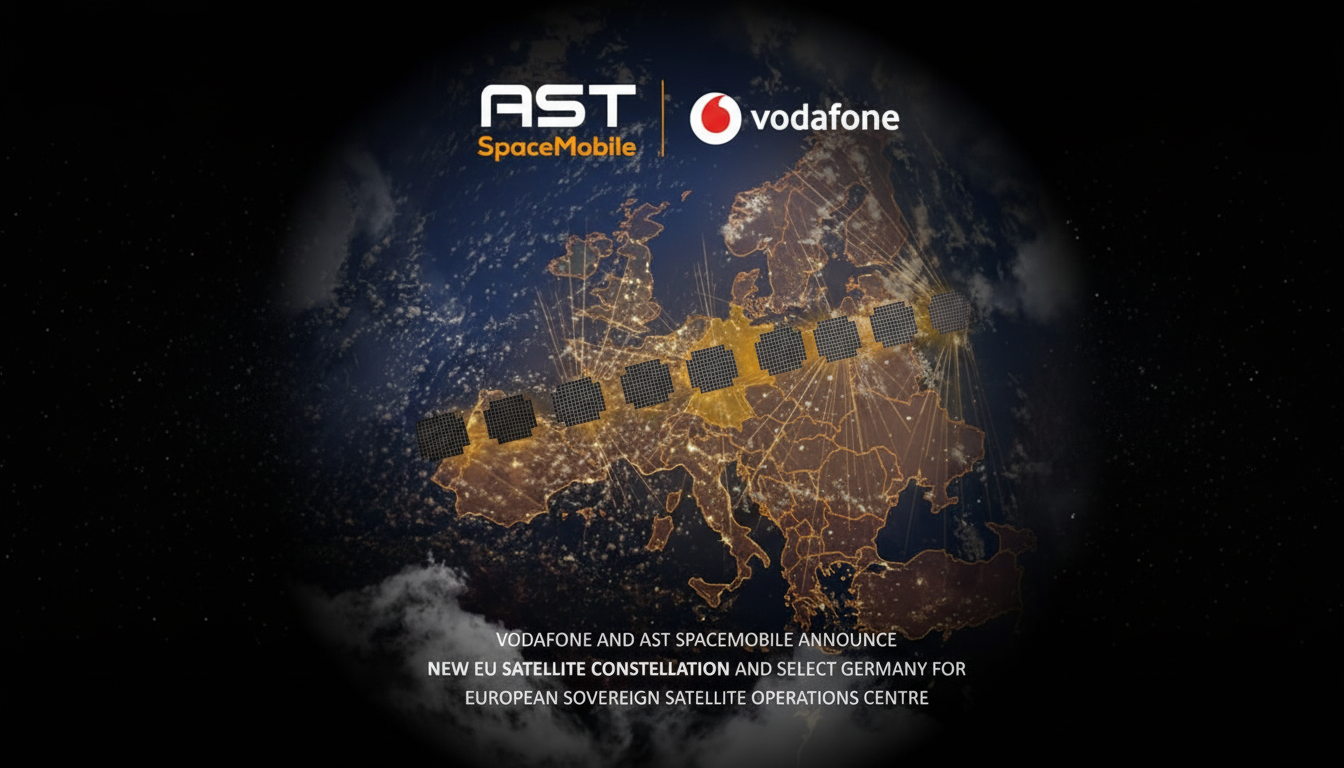Vodafone and AST SpaceMobile are moving ahead with a Europe-focused satellite-to-phone service, positioning operations to be anchored in Germany as the companies gear up to directly challenge Starlink’s expanding footprint. A new European operations center will oversee a low Earth orbit (LEO) constellation that aims to bring mobile broadband to commercial service in the EU targeted for 2025 and 2026, according to the partners.
EU operations hub to coordinate space-to-phone service
The proposed hub — with the location yet to be determined, either Hannover or Munich — will allocate capacity, manage traffic, and serve as a gateway between satellites and standard 4G and 5G cores. Vodafone wants to embed space-based connectivity in Europe’s regulations and security by securing spectrum, beam mapping, and cross-border mobility from inside the single market. The company is framing it as a bet on European resilience, including for emergency services and disaster response, so they can make use of the coverage where terrestrial networks are thin or impaired.

The operations center will serve SatCo, a jointly owned European satellite service provider that will sell capacity wholesale to carriers throughout the region. Rather than reselling consumer dishes, the model is more akin to terrestrial roaming: Mobile operators leverage their own spectrum and customer relationships, with a satellite layer that acts as a backup connectivity plan in rural communities, along coastal corridors, and on transport routes.
Timelines, spectrum and standards for the EU rollout
Vodafone anticipates edge coverage to be rolled out in 2025–26, according to 3GPP Release 17 specifications for non-terrestrial networks (NTN). Unlike traditional satellite broadband with special ground stations known as barrier-to-entry terminals, AST SpaceMobile’s technology targets unmodified phones using low-band licensed spectrum (e.g., 700–900 MHz) owned by carriers. That choice of spectrum is crucial because low frequencies travel farther, which boosts the link budgets from LEO to handsets on a street or inside a car.
AST SpaceMobile’s test satellite, BlueWalker 3, has already completed voice calls, messaging, and broadband sessions directly to retail handsets. The company has announced peak downlink rates in the tens of megabits per second in trials, a significant proof point toward scaling up to its larger commercial BlueBird satellites. That performance isn’t going to replace fiber, but it meaningfully raises the floor of connectivity in areas where cell sites are few and far between.
A competitive LEO landscape as EU rivals intensify
SpaceX’s Starlink continues to be the front-runner in terms of size, with more than 6,000 satellites in orbit as well as a public count of over 8 million subscribers worldwide, according to company disclosures. It also has started direct-to-cell tests with T-Mobile in the US. But the consumer model is based on customer premises equipment and a vertically integrated network, which makes it less in step with Europe’s operator-led vision for spectrum stewardship and market competition.
AST SpaceMobile is responding with a carrier-first play.
Outside of Vodafone in Europe, it has deals with AT&T and Verizon in the US and partners across Asia and Africa. To de-risk launches, AST has secured several vehicles through Blue Origin and India’s national space agency, as well as from Elon Musk’s SpaceX. Meanwhile, Europe’s current LEO backup option — Eutelsat OneWeb — is getting more and more enterprise and government interest through distribution partners, even if it has a different focus area than providing direct-to-smartphone services.

Strategic autonomy also looms large. EU officials have made no secret of wanting to reduce reliance on single-vendor ecosystems, with the secure connectivity program named Iris2 allocated budget equivalent to around €10 billion in order to meet government, critical infrastructure, and resilience requirements. A German control center for commercial mobile satellite connectivity fits in well with those sovereignty goals, not competing, but complementary to sovereign European initiatives.
Why this is important for European carriers
For operators, satellite augmentation offers the potential for coverage differentiation and additional revenue without a complete redraw of the radio access network. GSMA research has long detailed stubborn rural and maritime not-spots; a satellite layer can boost service reliability for logistics, agriculture, tourism, and emergency services — while enhancing adherence to EU compliance with universal service obligations within the framework of new goals under the EU Digital Decade.
Serving carriers keep a stranglehold on capabilities including authentication, lawful intercept, emergency call routing, and quality of service because the network is tapping into licensed spectrum and tying into existing cores. That architecture is purpose-fit to Europe’s regulatory substrate — national overseers like Germany’s Bundesnetzagentur and EU-level guidance — where spectrum use, privacy, and cross-border mobility are tightly controlled.
Key risks and what to watch next for EU space-to-phone
Execution risk is real. Constellations are capital-intensive to build and launch cadences can slip, while spectrum coordination through the ITU and national authorities is complicated. The end-user experience will also be closely watched: sustained throughput per beam, latency targets in tens of milliseconds over LEO, and seamless handover from terrestrial cells to satellite passes will determine customer satisfaction.
Short-term goals include making the final decision on a German site, licensing for gateways, further satellite launches, and early commercial trials with European carriers. Pricing models — such as coverage-insurance bundles, pay-as-you-go options similar to those for rural zones, or premium-tier offerings — will give the market an indication of how aggressively operators plan to promote satellite reach.
The bigger takeaway: Europe is shifting from aspiring to actionable on space-enabled mobile. If Vodafone and AST SpaceMobile can stick to their schedules, the EU could acquire a home-field alternative that integrates with terrestrial 5G and reduces dependence on non-European constellations, all delivered as a tangible win for consumers who just want their phones to work anywhere.

